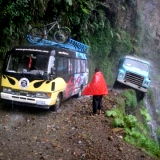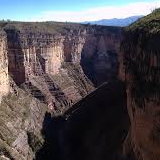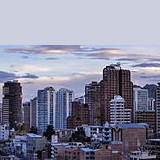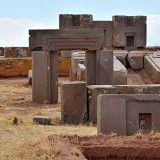
|
Tiwanaku Bolivia Last Updated: 03/13/2023 |
| Tiwanaku is a ruined ancient city near Lake Titicaca in western Bolivia. Tiwanaku (or Tiahuanaco) was the capital of the Tiwanaku empire between c. 200 - 1000 CE and is situated in the Titicaca basin. At an altitude of 3,850 metres (12,600 ft) it was the highest city in the ancient world and had a peak population of between 30,000 and 70,000 residents. | |
| The Tiwanaku empire, at its largest extent, dominated the altiplano plains and stretched from the Peruvian coast to northern Bolivia and included parts of northern Chile. Tiwanaku is located near the southern (Bolivian) shores of the sacred Lake Titicaca and it would become the centre of one of the most important of all Andean cultures. The architecture, sculpture, roads, and empire management of Tiwanaku would exert a significant influence on the later Inca civilization. Tiwanaku is known for its impressive stone architecture, including monumental buildings, courtyards, and ceremonial plazas. One of the most notable structures at the site is the Akapana Pyramid, a stepped pyramid that was once the center of religious and political life in the city. The site also features a number of sculptures and carvings that depict the religious and cultural beliefs of the Tiwanaku people. These include images of mythical creatures, gods and goddesses, and intricate geometric patterns. Tiwanaku is believed to have been an important center of trade, culture, and religion in the Andean region, with connections to other civilizations throughout South America. The Tiwanaku culture was characterized by a complex social hierarchy, sophisticated agricultural practices, and a deep reverence for the natural world. Visitors to Tiwanaku can explore the ruins of the ancient city, which are spread out over a large area. Guided tours are available, and there is also a small museum on site that features artifacts from the Tiwanaku civilization. The site is easily accessible from La Paz and other major cities in Bolivia. | |
Website Wikipedia
Bolivia » Bol
Place » Historical Place

|
Salar de Juni Place » Historical Place The Salar de Uyuni, located in southwestern Bolivia, is the world's largest salt flat and one of the most breathtaking natural landscapes on the planet. This vast expanse of salt crust covers an area of over 10,000 square kilometers (3,900 square miles) and offers a surreal and otherworldly experience for visitors. 285 views 💖 1 👍 0Bolivia |

|
Yungas Road Place » Outdoors The Yungas Road, also known as "Death Road," is a mountainous cycle route about 60 km long which links the city of La Paz and the Yungas region of Bolivia. It draws about 25,000 tourists per year and is a major La Paz tourist attraction. Many tour operators cater to downhill mountain biking, providing information, guides, transport and equipment. 645 views 💖 4 👍 0Bolivia |

|
Torotoro National Park Place » Outdoors Torotoro National Park is a national park located in the department of Potosi, Bolivia. It was established in 1989 and covers an area of 165 square miles (428 square kilometers). The park is known for its unique geological formations, including rock formations, canyons, and caves. 673 views 💖 4 👍 0Bolivia |

|
Bolivia Place » City Bolivia, officially the Plurinational State of Bolivia, is a landlocked country located in western-central South America. The population increased from 8,274,325 (from which 4,123,850 were men and 4,150,475 were women) in 2001 to 10,059,856 in 2012. Bolivia has a diverse landscape that includes the Andes mountain range, the Amazon rainforest, and the Altiplano plateau. 590 views 💖 1 👍 0Bolivia |

|
Puma Punku Place » Historical Place Puma Punku is an ancient archaeological site located near the city of Tiwanaku in Bolivia. It is believed to have been built by the Tiwanaku culture around 500 AD, and it is considered one of the most important and mysterious archaeological sites in South America. 548 views 💖 1 👍 0Tiwanaku, Bolivia |
